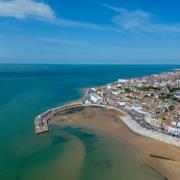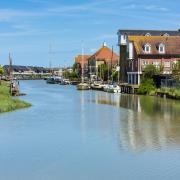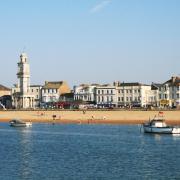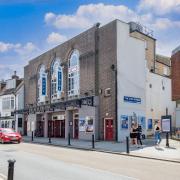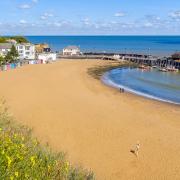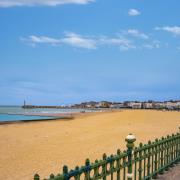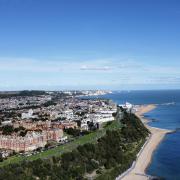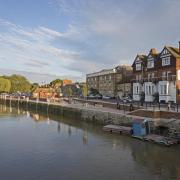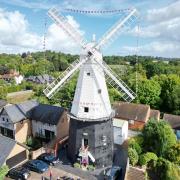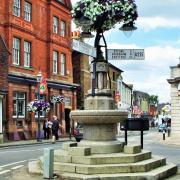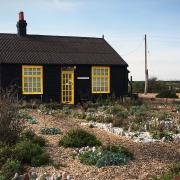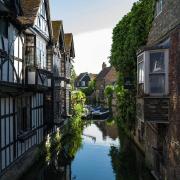Wonderfully undisturbed by the passage of time, Cranbrook is lively and welcoming, with artistic and rural traditions dating back centuries – and it has the tallest smock mill in England
Cranbrook is a town that looks and feels as if it’s a film set for a Miss Marple epic: a peaceful High Street with 1950’s shopfronts, a wonderful church and a historic windmill dominating the skyline above white weatherboarded houses, many of which date back to the 16th century. Just as in the 1950s, there are no brash chain stores, the parking is a breeze and every cottage has charisma. Many of the houses have individual names, there are some fine timbered Tudor homes, the views are breathtaking and strangers give you smiles. The town has known boom times and had its share of knockbacks, but always bounces back. It’s a lively, welcoming, place with artistic and rural traditions that go back centuries and a spirit of optimism and rugged individuality that’s as tangible today as it ever was.
Around townThe High Street and Stone Street, Cranbrook’s main arteries, meet at the town’s mid point, the spot where the old Vestry Hall houses the Weald Information Centre, which is conveniently placed to start your tour. St Dunstan’s church, to the right, is a fine golden building, colloquially known as the Cathedral of the Weald; there’s a large rambling churchyard, fringed by Church House, originally a school endowed to teach the poor children of the parish. At the Weald Information centre you’ll find friendly staff, free leaflets and guides. Almost opposite Vestry Hall, in Stone Street, is the historic George Hotel. Carry on down the hill and you get to the most scenic part of town, with views that have inspired artists for at least a century. First you come to lovely old weatherboarded Tudor House, the premises of David Merewether Photography (01580 713928), and further down on your right is a steep alleyway leading to the now-derelict Providence Chapel, an interesting polygonal structure built in 1828. Carry on down Stone Street to where the road forks: shortly you’ll see the grand Union Windmill, its sails apparently close enough to touch. St David’s bridge is a steep downward slope leading to The Hill, while to the left are a row of beautiful white cottages (Waterloo Road); continue along Waterloo Road and you come to the grand buildings of Cranbrook School. Go back to the fork in the road and turn sharp left and you’ll see Tiffin’s Bar and restaurant, opposite which is Forge House, completely covered in ‘mathematical’ tiles, made to simulate brickwork. The road now ascends steeply and on the right there you’ll see The Particular Baptist Chapel (1787) with its incongruous front-garden tombstones, and further along is The Old Bakery (1650), plus some cottages (The Old House at Home, Hundred House, etc.). At this height you get a great vista of St Dunstan’s and the majestic brickwork of Cranbrook school to the right. Keep going and you get to Union Mill on the left, which is well worth a visit. Back at the town centre you’ll find Cranbrook museum on Carriers road, beyond the church. The High Street, directly opposite Verity Hall, offers plenty of good shops, all of them independent traders, and near the end, on the left, is The Old Studio and Broadcloth Cottage, the studio once shared by artists Frederick Hardy and Thomas Webster.
Major attractions• The excellent Weald Information Centre (01580 715686) in historic Vestry Hall. • St Dunstan’s church and churchyard. Marvellous golden stone building with a splendid churchyard, which boasts a large Turkish oak tree planted to commemorate the 1862 wedding of the Prince of Wales. • Union Windmill, the tallest smock mill in England (01580 712256).• Cranbrook museum (01580 712929 or 01580 712475 for the curator, Rod Dann). Originally this was four medieval cottages, now knocked together to house a huge collection of exhibits including Roman artifacts, agricultural and rope-making implements and the Boyd Alexander museum of stuffed birds (the largest in UK outside London’s Natural History Museum) and a room devoted to the Cranbrook Colony of artists (see below). • George Hotel and Brasserie (01580 713348) A 14th-century inn that’s one of the oldest buildings in town, offering excellent cuisine.
Past and presentNamed after the river Crane that runs through the town, ‘Cranebroc’ became prosperous as a result of an influx of Flemish weaver, fullers and dyers who established a broadcloth industry in the 1300s. As a result, Cranbrook grew for three centuries, until disaster struck around 1600 when the export of cloth to Flanders was prohibited. It escaped a ‘credit crunch’ because there were still regular markets, and tanning, rope-making and agriculture remained. Famous for its independent spirit, Cranbrook bucked the trend of the English feudal system, whereby a Lord of the Manor was at the apex of the social hierarchy. Instead, the town’s power has always been in the hands of independent merchants and farmers. Cranbrook School was started by local magnate John Bluebery in 1518 and expanded in Victorian times to the prestigious boarding school it is today. Although the coming of the railways and the Industrial Revolution spelt the demise of the town’s traditional market, fruit growing and agriculture flourished steadily and the 1840s saw the arrival of The Cranbrook Colony, a flamboyant group of ex-London artists who kick-started Cranbrook’s artistic traditions. For a comprehensive history of the town, get A short illustrated history of Cranbrook, �10, by Peter Allen, from Crane Books, 01580 713567.
Considering a move? You won’t have to pay London prices, unless you find a listed building in the town centre. As a general guide, a one-bedroomed flat is �100-150,000, a two-bedroomed flat, �145-174,000, and a two-bedroomed house is �140-185,000. For a three-bedroomed semi, you’d pay �200-225,000, while a four-bedroomed detached home would be upwards of �320,000. Two of Kent’s fine independent secondary schools, Benenden (girls) and Tonbridge (boys) are relatively close by.
DID YOU KNOW?
• The melody for the Yorkshire folk song On Ilkley Moor Baht At was originally that of Cranbrook, written by local hymn writer Thomas Clarke• In 1655 George Fox, founder of Quakerism, visited the town and made a number of conversions• In 1630s several children of the Vicar of Cranbrook, William Eddye, sailed to New England and achieved positions of importance • Most of the surrounding area was originally thickly wooded with clearings called dens, explaining the 'den' suffixes on several local villages • Artist J C Horsley, one of the Cranbrook colony, designed the first Christmas card in 1843 • From the 14th to the 17th century, Cranbrook was one of the wealthiest and biggest towns in Kent• Vita Sackville-West, who lived in nearby Sissinghurst, described the town of having ‘an air of busy peace’



